In a conversation with TechRadar published Friday (July 11), Sameer Samat, president of the Android Ecosystem at Google, asked reporter Lance Ulanoff why he was using a MacBook Pro, Apple Watch and iPhone to understand about the apps he uses to manage these devices.
“I asked because we’re going to be combining ChromeOS and Android into a single platform, and I am very interested in how people are using their laptops these days and what they’re getting done,” Samat said.
The report notes that this has been a big year for Android, with the ecosystem recently unveiling its Android 16, which Samat says was the platform’s “biggest design change in Android in three or four years.”
As PYMNTS wrote in May, the phone’s update includes a design called Material 3 Expressive, phones and watches using Google’s operating system will be “more fluid, personal and glanceable,” as Mindy Brooks, vice president of product management and user experiences, Android platform, wrote in a company blog post.
In addition, the Tech Radar report discussed the combination of Android phones with Google’s Gemini artificial intelligence (AI) model.
Calling it “that Gemini Experience,” Samat says users who switch from other phones are “seeing over and over again what they’ve been missing.”
He demonstrated how Gemini could both summarize a long YouTube video and break down its claims (with time stamps) by using in sources from the Web, something Tech Radar described as Gemini “leaning into its Google search roots.”
“What I’m getting at,” Samat said, “is that Gemini integrated in a phone really provides a much more helpful experience. And when consumers do move over from an iPhone, they instantly realize that they’ve been missing a lot of this.”
PYMNTS looked at the state of AI-powered search — as well as the possible future of Google — in a recent interview with Adam Behrens, CEO of retail AI tech startup New Generation.
He argued that in five years, Google won’t be “a list of links,” but “a service where you get answers, then actions, which changes how people shop and what they expect.”
“The traditional ad model starts to break down because there’s less screen space and fewer choices; you either show up ready to be picked, or you’re invisible,” Behrens added.
“For brands, it means they can’t just live behind a website anymore. They need to show up across the entire AI ecosystem so they’re shoppable, searchable and ready for whatever agent your customer is using.”
